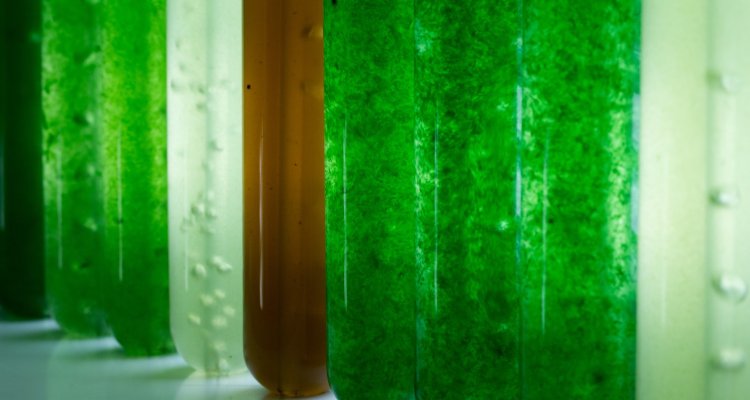
Project
Microalga as a sustainable oil crop for biofuels
Oils derived from microalgae can be an alternative to the tradition oil crops. Nannochloropsis strains with superior characteristics are one of the most interesting candidates for sustainable and cost-effective large-scale lipid production for biofuel production process.
Summary
Establishing a sustainable bioeconomy will be indispensable in the long run. However, currently employed agricultural production platforms are not efficient enough to deal with the increasing demand for biologically produced oils. In this regard, alternative production organisms like oleaginous microalgae have great potential. Microalgae are photosynthetic microorganisms that, just like plants, need only (sea)water, CO2, and sunlight to grow. However, there is not enough knowledge on cellular processes in industrially relevant strains and on large scale production systems. Consequentially, large scale oil production from algae is not efficient yet.
Lipids produced by microalgae can be used to replace palm oil, fish oil and fossil oils for food, feed and sustainable fuels. In order to do so, the project will focus on understanding the fundamental metabolic mechanisms underneath lipid production. This approach will allow us to maximize the yield and develop innovative and cheap solutions to make the production of microalgae a reality.
Large physiological differences, e.g biomass and oil productivity, content on omega -3 fatty acids, can be found within the genera Nannochloropsis. In this project a systematic comparison on different strains and species from the same genera will be done on cellular (transcriptomics and lipidomics) and physiologic levels to unravel the cellular mechanisms behind these differences and generate new knowledge on lipid metabolism in general.
Aim
The overall goal of this proposal is to screen and select the highest performing oleaginous species within the marine microalga genera Nannochloropsis under simulated outdoor cultivation conditions and to scale up the process to pilot scale for lipid production for biofuels.
In addition, the project aims at generating knowledge on lipid metabolism and fundamental insights into key metabolic processes that determine photosynthetic efficiency and carbon partitioning towards TAF and omega -fatty acids during replenish growth and nitrogen starvation for the genus Nannochloropsis.
Approach
In this research innovations in algal biology
and production technology are integrated. In the pilot facility, AlgaePARC,
research will be done to bridge the gap from fundamental research under
laboratory conditions towards outdoor production for the production of lipids .This
will be done by:
1. Comparison and selection of the highest lipid producing strains within the genus Nannochloropsis
- A panel of different strains from different Nannochloropsis species will be grown in controlled conditions in a High-throughput screening platform (HT24).
- Growth, physiological status, photosynthetic parameters and characterization of lipid accumulation will be measured under replenished and nitrogen depleted cultures, for different conditions of light intensity.
2.Understanding lipid metabolism and regulation: Comparative transcriptomics and lipidomics of high and low lipid producing strains
Highest and lowest lipid producers will be compared in more detail to unravel the underlying causes for the differences.
- Cultivation of these strains under normal growth conditions will be done followed by nitrogen starvation then a recovery phase (by adding replenished medium after the starvation period) will be done in highly controlled 1.8 L photobioreactors.
- Samples will be taken for transcriptomic and lipidomics analysis, in order to compare the expression levels under the three phases to identify the genetic factors that are of importance for the observed physiological traits, for high-lipid vs low-lipid producers.
- Similar experiments will be conducted with 13C isotope labelling to be able to determine carbon partitioning in the cells during the three phases: growth, starvation, and recovery.
- Lipid classes and profiles will be measured as well as photosynthetic parameters.
- TEM analysis will be done to visualise the changes taking place in the cell structure and different organelles.
3. Optimise production process- effect of dynamic light and temperature conditions on lipid productivity
- The strains with the highest lipid productivity, with the focus on TAG and Omega-3 Fattya cids, will be further optimized under simulated outdoor dynamic light conditions.
- Climatological conditions as found in Egypt will be simulated. To investigate the effect of light intensity, spectral quality and photoperiod on the metabolism of microalgal lipids and their fatty acid composition
- Finally, the process will be optimised for highest lipid production.
Scale- up to pilotscale at AlgaePARC
- Lipid productivities obtained at lab scale will be validated at pilot scale at AlgaePARC and results will be used to study the potential of microalgae production in Egypt by adapting the existing techno-economic model developed by the hosting group to the climatological and social conditions found in Egypt.
- Production costs will be estimated, energy balance will be determined, and a sensitive analysis will be done to identify the parameters of most importance to reach economic feasibility.
This will bring forth the most productive Nannochloropsis species, optimized for large-scale microalgal oil production for biofuels.
The selected strain will permit a near-term realization of an economically viable process for industrial TAG production in microalgae, which will significantly contribute to the advancement of a transboundary biobased economy and constitute a gain in fundamental knowledge about microalgal metabolism.
Thesis project
Would you like to know more or to work on this project? Please contact omnia.hamdy@wur.nl for more information or a thesis position.